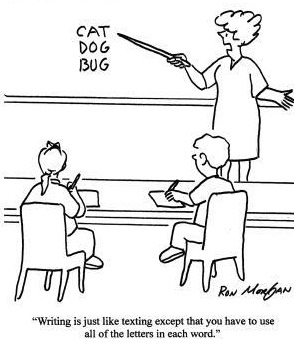Blog post
25/05/2013 14:00
 (Retrieved from https://thekennedykorralblog.blogspot.com.au/2011/10/funny-teacher-comics.html)
(Retrieved from https://thekennedykorralblog.blogspot.com.au/2011/10/funny-teacher-comics.html)
The usability of ICTs in the classroom has allowed teachers to recently incorporate technology into many lessons, activities and units. However, many teachers are still not familiar with the capability of ICTs to be used for assessment purposes across many curriculum areas. Based on experience, I can reflect that I also was a teacher who completely embraced ICTs for individual lessons and activities but neglected to recognise its applicability to both formative and summative assessment processes.
Kent & Campbell (2013) detail that technology has the ability to be used in both teaching and assessment approaches to improve student learning experiences and outcomes. As new technological innovations are constantly arising, there are a multitude of available modes of technology that teachers can employ to create assessment pieces that are both based on the curriculum and incorporate the use of ICT. I have chosen to select a few modes of technology as listed by Kent & Campbell (2013) and provided my own suggestions as to how I would apply them in the classroom as well as any issues that could potentially arise:
1. Blogs
- Blogs are essentially a technological version of journals which teachers have been using as assessment for many years. However, blogs allow the teacher to view the student’s contributions in a chronological sequence which provides an understanding of the sequence of the student’s learning progress. They can also be used to facilitate formative assessment through observation or notes and feedback can be given to students between posts which is an important part of the assessment process.
2. Wikis
- I believe wikis are a great tool to employ in the classroom, especially in the upper years context however I am wary of their use as an assessment. I understand that they can be used to assess individual contributions and the development of group work but as the context of a wiki is to constantly edit and change others work I would not use it as a summative assessment for an individual child. Grant (2006) supports this fact that when assessing, students should be given an opportunity to produce their own individual work instead of having unavoidable changes that could potentially occur in wikis.
3. YouTube
- YouTube can be an excellent resource to use in conjunction with a task as a means of assessment for students. I have found that YouTube (or using other recording devices or movie making programs) allows for a more technologically appropriate and ICT incorporated version of oral or group presentations. Students can film and edit their presentations whilst adding in other multimedia elements to enhance their productions. I would definitely consider the use of such a resource in my assessment planning as a teacher.
To conclude, using ICTs with assessment is a contemporary way of allowing students to use their skills acquired through being digital natives to their advantage in a classroom context. It gives students the opportunity to showcase these skills and learn how to apply them to educational content to demonstrate their own learning and knowledge. Teachers can also benefit from using these assessment techniques and by challenging themselves to modify old forms of assessment, allows them to develop their personal digital pedagogy and also improve their class’ outcomes through a combination of curriculum standards and current teaching trends.
References:
Grant, L. (2006). Using wikis in schools: a case study. Futurelab, 1-9.
Kent, P., & Campbell, C. (2013). Assessment for teaching today. South Yarra: Macmillan Teacher Resources.